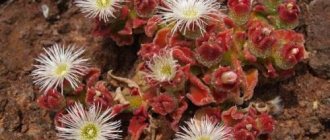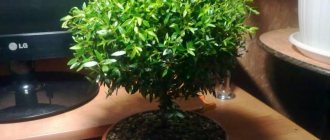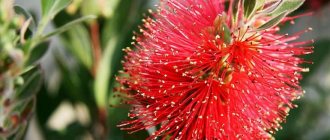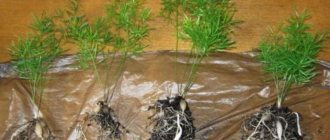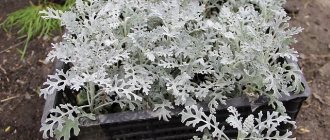In order for medlar to grow well at home from seed, you should know the characteristics of this plant and the rules for planting it. It grows in the form of a tree, which is valued all over the world not only for its attractive appearance, but also for its interesting berries. Many have heard about this culture, but not everyone knows how medlar grows.
Care for medlar at home
Growing medlar from seed
Growing medlar from seed can be done at home.
The bone extracted from the pulp is planted no later than three days later. If you purchased medlar seeds in a store, you should understand that a plant grown from them is unlikely to produce a harvest, but medlar from the seed of an eaten fruit will almost certainly bear fruit. The substrate for medlar can be purchased at the store, or you can make it yourself from equal parts of leaf soil, humus, sand and peat. Fill the pot with drainage holes with the substrate, remembering to first place a layer of expanded clay in it. Medlar seeds are buried 2 cm into moistened soil (up to six seeds can be placed in one pot), after which the surface is covered with film or covered with glass. While waiting for germination, the crops are placed in a warm, bright place, for example, on a windowsill.
In no earlier than a month, sprouts will appear, and it will be necessary to shade the seedlings from direct sunlight, ventilate the crops daily and remove condensation from the covering so that the plants are not affected by fungal diseases from dampness. When the seedlings grow to 2 cm, the covering is removed from the pot, and the seedlings are kept at a temperature not lower than 18 ºC. If it's summer, place the pot with medlar on the balcony or terrace, protecting the young plants from gusts of wind, drafts and bright sun. Keep the substrate slightly moist by watering it 2-3 times a week.
Once the medlar has sprouted, its growth will be rapid: in a month the seedlings can grow up to 15 cm, and then, so that they do not interfere with each other, they are planted in separate deep containers with a soil mixture of coarse river sand, peat and humus. Weak seedlings may die after transplantation, but nothing can be done about it - natural selection... And large and strong plants will become even larger and stronger.
Home medlar will bloom only in the third year after transplanting into a separate container at the end of autumn or early winter, and the first fruits may appear by the New Year. You can shape the crown of your home medlar only after flowering, although this is not necessary: you can give the crown a shape, or you can let it look natural, cutting off only thickening, weak, diseased and damaged branches.
Properties of medlar - harm and benefit
Beneficial features
Medlar fruits contain iron, calcium, potassium, phosphorus, iodine, magnesium, zinc, selenium, sodium, fructose, sucrose, citric and malic organic acids, vitamins A, C, B1, B2, B3, B6, B9, pectins, tannins and phytoncides, which promote recovery from gastrointestinal diseases, normalizing intestinal function, relieve pain from stones in the urinary tract and kidneys.
A decoction of unripe medlar fruits relieves inflammation and stops intestinal bleeding. A decoction of leaves collected from flowering medlar has an anti-inflammatory, strengthening, and hemostatic effect. An alcohol tincture is made from the fruits of the medlar, which is used to treat bronchitis and asthma in Japan.
Rich in antioxidants, dietary fiber, fructose and citric acid, low-calorie loquat is often included in the diet. It promotes healing from diabetes, increases the body's resistance to infections, eliminates the symptom of kidney dysfunction, increasing their filtering capacity, removes waste and toxins from the body, improves vision, the functioning of the digestive organs, eliminates intestinal disorders, such as constipation, helps stabilize blood pressure, relieves intestinal colic and prevents runny nose.
In the photo: Medlar is not only a healthy plant, but also tasty
Due to the high content of vitamins, macro- and microelements, medlar is recommended for pregnant and breastfeeding women who do not have an individual intolerance to the product. Masks are prepared from the pulp of the fruit, giving the skin a healthy color, eliminating age spots and smoothing out fine wrinkles.
Various dishes are also prepared from medlar, for example, jams, preserves and compotes. Medlar juice is easily fermented, so it is used to make liqueurs, wine and liqueur. A drink reminiscent of coffee is brewed from medlar seeds.
Contraindications
When introducing medlar into a child's diet, care should be taken as allergic reactions may occur. Loquat and especially its unripe fruits are contraindicated for those suffering from inflammation of the pancreas, gastritis with high acidity and peptic ulcers of the stomach and duodenum. It is also undesirable for these people to drink wine and medlar juice. But jam or preserves made from it have a beneficial effect even on a sick body.
Growing from seed
From a seed you can grow a full-fledged tree, which will not be inferior in its characteristics to the mother one. The main thing is to follow the technology correctly.
Seed preparation
For planting, you can only take fresh seeds. They need to be freed from the pulp shortly before being immersed in the ground. To speed up the germination of seeds, which have a dense shell, they need to be scarified. Sandpaper or a file is suitable for this. Immerse the seeds in warm water for a day, or better yet, in a solution of potassium permanganate. This will disinfect the future plant. Those bones that do not sink but float are thrown away. They are not suitable for germination.
Soil preparation
The soil for planting must be neutral. An earthen mixture consisting of:
- turf (4):
- leaf soil (2);
- coarse sand (1);
- compost (1).
The soil is first loosened and moistened. Water should saturate it completely and pour out through the drainage holes of the planting container.
Landing rules
The medlar seeds are quite large. Therefore, each requires an individual container. Bury the seed 1.5-2 cm into moist soil. Water it and cover the top with film, forming a greenhouse. The exact landing time is difficult to determine. It depends on when you get your hands on fresh fruit. The seeds should not be stored, but should be planted immediately after eating the fruit.
How to germinate a seed
In order for the planted seed to sprout and develop further normally, it needs appropriate conditions. The container with the seed, covered with film, is placed in a bright place, but not in direct sun. Watering should be moderate. The liquid should not be allowed to stagnate, but the soil should not be allowed to dry out. The greenhouse must be regularly ventilated and condensation removed to prevent mold from appearing on the soil surface.
The first shoots will appear after 3-4 weeks if all conditions for preparing and planting the seeds have been met. When they reach a height of 2-3 cm, the cover can be removed for a certain time to allow the plant to get used to natural aeration. Maintain the ambient air in the room at a level not lower than +18 degrees. From time to time, the sprouts are sprayed with warm, settled water.
Conditions for seed germination
Next, you need to choose high-quality planting material and prepare an environment corresponding to the one in which the plant grows in nature.
How to plant a seed correctly
Caucasian medlar - growing in the garden in open ground
The prepared seed can be soaked in a disinfectant solution. Then a step-by-step stage of planting the seed is carried out:
- Place drainage in the container.
- Light and fertile soil is poured.
- Water the substrate.
- The seed is buried 2-2.5 cm.
Important! To create the necessary microclimate, the container with plantings is covered with glass or transparent film.
Creating greenhouse conditions
Under the covering material, the conditions necessary for rapid and friendly seed germination are created. Every day the film is removed to ventilate the plantings. The covering material and the walls of the container are wiped from condensation, otherwise fungus may form on them due to the large amount of moisture. When sprouts appear, remove the glass or film.
Reproduction of medlar from seeds is a labor-intensive but interesting process.
Pinching a seedling
In order for the medlar to have a beautiful shape, it begins to form when there are already 3 pairs of true leaves. To do this, pinch the top. After this procedure, the dormant lateral buds wake up and the plant begins to bush.
If you want to form a medlar in the form of a tree, you need to leave one main trunk and remove the lower side branches until they become lignified.
Note! Cut branches can be rooted by planting in a pot.
Detailed description of the plant:
Medlar, otherwise known as eriobothria, is a small tree that can reach a height of 2-3 meters, and is suitable for growing at home in a large pot, or for growing in greenhouses. The plant is often used to decorate interiors, decorate halls and corridors in institutions, and decorate shop windows.
In addition to the fact that medlar blooms for a long period, its buds emit a very pleasant aroma, and the plant blooms at a time when other plants are resting from forming succulent buds - from late October to mid-January. Even without flowering, medlar fits perfectly into any interior - its leaves are somewhat reminiscent of ficus.
The fruits of Japanese mishmula look like small apricots; after picking, the berries can be stored for quite a long time without signs of spoilage or loss of taste.
Growing medlar at home from seed:
It is quite easy to grow Japanese medlar from a seed at home, but in order for the whole process to be completed successfully, you must first of all know about the growth characteristics of the plant:
- Firstly, the seed must certainly be fresh, just taken from a ripe fruit. It separates perfectly from the pulp and does not need to be washed in water;
- Secondly, a plant that will be grown from a seed, and not by sprouting a twig or shoot, will retain all the qualities from the mother tree. Therefore, it is recommended to use only seeds from good fruits and healthy medlar for germination;
- Medlar needs to be replanted into larger pots 2 times a year - if the plant is immediately planted in a large pot, its growth will slow down, and all the plant’s energy will be spent on forming the root system;
- And finally, you should know that the fruits on the medlar will appear no earlier than three years after the start of growth, by which time it will have grown enough to hold juicy fruits on the branches.
Popular varieties
Different varieties of chinese trees have different organoleptic properties
The varietal diversity of medlar is very rich. Depending on the variety, Japanese or German, the fruits can be divided into two types: large pear-shaped ones with soft juicy pulp and small hard, apple-like fruits with noticeable sourness.
The most popular varieties of cup tree are presented in the table.
| Variety name | Properties |
| Champagne | The fruits are fluffy, yellow with creamy pulp with a slight sour taste |
| Tanaka | The fruits are orange, pear-shaped, weighing up to 70 g, with a delicate taste and aromatic pulp |
| Premier | Cream-colored yellowish-orange fruits with slightly sour flesh |
| Commune | Small round fruits weighing up to 30 g, slightly flattened, bright yellow in color |
| Sales | Rich orange fruits, large, similar to apricot both in appearance and taste |
| Morozko | Frost-resistant plant with a low level of trunk fragility, the fruits are large, aromatic, bright brown with a high content of nutrients |
Among the varieties loved by gardeners are also: Monreale (Italy), Thales, Tams Pride (Australia), Advance, Uze-fangzhong (China), Early Red (USA).
In Russia, the following varieties are recommended for cultivation: Sochi, Khvamli, Karadagskaya, Goytkhskaya.
Fruits of any variety tolerate transportation well and are stored for a long time, and the fruits of German eriobothria even need to be frozen to improve their taste.
Possible problems when growing a tree from a seed
If agricultural practices are incorrect, medlar may lose its decorative appearance. Diseases and pests can also be the reason why leaves dry out. The most common problems are:
- the roots rot. This occurs due to overwatering. To correct the situation, the medlar roots are cut to healthy fragments and sprinkled with charcoal. Then it is transplanted into new soil, having previously disinfected the pot;
- Leaves curl and wither. Possible reasons: keeping in a draft, abundant watering, excess nitrogen in the soil. You can restore a tree by moving the pot with the plant to comfortable conditions, reducing watering, reducing fertilizing with nitrogen;
- medlar grows slowly. Perhaps there are not enough nutrients in the soil, or the tree does not have enough light. Medlar prefers to be kept in good light; once a month it needs to be fed with mineral fertilizers;
- Aphids and spider mites appear on the plant. To eliminate the pest, the medlar is sprayed with a solution of laundry soap or insecticides.
Loquat affected by disease
Medlar fruits contain a large number of useful elements. An exotic lover can easily grow a tree from a seed. To do this, you need to wipe it with sandpaper, plant it in nutritious soil, and provide the necessary conditions. If you study information about how medlar grows and apply the knowledge in practice, in 4-5 years you can enjoy tasty and healthy fruits.
Chemical composition of ezgil fruits
Winterflower fruits are a storehouse of nutrients
Medlar fruits are consumed both raw and processed. 100 g of medlar fruit contains 47 kcal. They are low in protein (0.43 g) and fat (0.2 g), but high in carbohydrates (10 g).
These aromatic fruits contain 10% sugars and 7% malic acid, citric acid, vitamins A, C, almost all B nutrients, folic acid, iron, manganese, potassium, sodium, selenium, zinc, calcium, aromatic and tannin substances, phytoncides.
Varieties of fruit tree
Having figured out what medlar is, you should familiarize yourself with what types of wood are used in gardening. This southern culture comes in 3 types, but only 2 of them have gained widespread popularity. These include Japanese medlar, as well as German or otherwise Abkhazian. Both varieties are shade-tolerant, not demanding on soil composition and can easily tolerate drought. But there are also differences between them.
Japanese medlar
Japanese medlar is an evergreen tree 3-5 m high, but there are exceptions up to 8 m. The shoots and branches of the plant are densely covered with a red-gray edge. The leaves are large, oblong, up to 25 cm long and about 8 cm wide. The upper surface of the plates is glossy dark green, the reverse side is grayish with pubescence.
This variety of medlar has a fruiting period that is radically different from other garden trees. Fruits begin to ripen in late May - early June. Their shape can be pear-shaped or round. On the branches the fruits are collected in clusters. The weight of each varies from 20 to 100 g, size is about 7 cm.
The Japanese variety of the crop prefers a warm climate and rocky soil. At a temperature of -15 degrees the plant dies. Therefore, Japanese medlar can only be grown in the southern regions or as a houseplant.
Japanese loquat fruits are similar to apricots
Based on the Japanese medlar, it was possible to develop varieties and hybrids that are distinguished by high taste qualities of the fruit and a pleasant aroma. The most popular of them:
- Tanaka;
- Silas;
- Champagne;
- Morozko;
- Early red;
- Montreal;
- Thales.
German medlar
German medlar is often called Abkhazian, Caucasian or Crimean. This species is considered more decorative, but deciduous. The height of the tree does not exceed 3 m. The plant is easy to care for and has increased frost resistance. The fruit ripening period occurs in November.
For full tree growth, a warm winter and cool summer are necessary. Therefore, this variety can be grown outdoors in regions with a temperate climate.
The taste of the fruits of the German medlar is sweetish, but tart. Therefore, to improve it, it is recommended to remove rounded fruits from the tree after the first frost or put them in the freezer for several days.
Important! There is often confusion when writing the name of this tree, so when choosing murmul or medlar, the latter is correct
Types and varieties of medlar
As we have already mentioned, of the three species of the genus, only German medlar, or Caucasian medlar, or Crimean medlar is grown in culture - the plant that we described at the beginning of the article. However, there is also Japanese medlar, or eriobothrya, or loquat, or shesek - a small evergreen ornamental and fruit plant grown both in open and indoor ground. Loquat belongs to the genus Eriobothrya of the Rosaceae family, that is, it is a relative of the German medlar, but in fact is not a medlar.
Japanese medlar (Eriobotrya japonica)
Reaches a height of 8 meters. Both the shoots and inflorescences of the plant are reddish-gray with thick felt pubescence. Oval leathery leaves, glossy on the upper side, sessile or on short petioles, reach a length of 25 and a width of 8 cm. They are also densely pubescent below. White or yellow five-petaled flowers with a diameter of 1-2 cm are collected in terminal paniculate inflorescences. The plant tolerates cold well, and with age its winter hardiness becomes increasingly higher. Of the varieties of medlar (Eriobothrya) Japanese, the most famous are:
- Champagne is a plant with fleecy yellow fruits with delicate pulp;
- Morozko is a variety for growing in a greenhouse or at home, the fruits of which are devoid of astringency;
- Silas is a variety with fruits weighing about 80 g, similar to apricots;
- Tanaka - this plant has pear-shaped fruits, orange-yellow color with pinkish flesh, sweet and sour taste.
In the photo: Japanese medlar (Eriobotrya japonica)
Care for medlar in apartment conditions
In order for a young plant to feel good, you need not only to water it correctly, but also to choose the optimal place in the room.
Also, special attention should be paid to watering. After all, a lot depends on the amount of moisture
Lighting
This is one of the important conditions for growing medlar at home. The tree grows best on windows facing south. It also feels good in the southeastern part. The plant produces a bountiful harvest only if the flowerpot is not in the shade.
Room temperature
Medlar is a tropical plant, so the indicators must be appropriate. The optimal numbers are 20 – 250 C. When growing indoors, you must ensure that the thermometer does not fall below 150 C. In the warm season, it is recommended to take the pot out into the fresh air. This could be a balcony or terrace. In winter, the tree is kept on the windowsill or away from the window. In the second case, installation of additional lighting is required.
Substrate for planting
Before planting medlar, you need to prepare the mixture. A peat substrate is best. You can buy it at any flower shop
When growing such a tree, it is important to ensure that the soil has neutral acidity levels.
To prepare the soil yourself, you will need:
- four parts of turf soil;
- one part sand (coarse);
- two parts of deciduous soil;
- one part compost.
All components must be mixed well. The resulting substrate does not require additional processing, so it can be immediately used for the procedure.
Transfer
If you follow the rules of soil renewal, you can be sure that the tree will always grow well and bear fruit. Unfortunately, not everyone knows when to replant a medlar, so often the leaves begin to fall off and the tree does not grow in size.
The soil should be changed once a year. To do this, you need to use the “transshipment” method. If the plant has grown significantly, then the flowerpot will need to be replaced. Mature crops need to change the soil every three years. The pot should be several centimeters wider than the root system itself. Be sure to place drainage at the bottom of the container. To do this, you can use pebbles or crushed broken bricks. Small crushed stone also performs its tasks well.
Fertilizer
The tree should be fed from early April to September. The number of procedures performed should not exceed two times every 30 days. Complex preparations are best suited for this. A good option are products designed for cacti and indoor roses.
Irrigation
Watering the crop directly depends on the season. In the summer, when it is hot outside, the tree needs to be irrigated frequently and abundantly. The soil should always be slightly moist. Winter is a dormant period for the tree. Therefore, the procedure must be carried out to a minimum, while ensuring that the earthen lump does not dry out completely. Water for irrigation should be taken only at room temperature. It is recommended to let the liquid sit well before use.
Trimming
It is necessary in order to form a beautiful bush. Using scissors, you need to periodically remove the tops of the shoots. To speed up their growth, you will need to cut off the peak part of the plant. This significantly activates the growth of lateral branches.
Pests
The tree is often attacked by insects. The plant can also suffer from improper care. If the medlar leaves begin to dry, you need to carefully examine their back and front sides. Often, such a sign appears as a result of the development of insects. In the case of foreign individuals, the tree must be treated with an insecticide. Also, wilting of leaves can be observed as a result of waterlogging of the soil. If nothing is done, the root system will rot and the plant itself will die.
In order to get rid of sooty fungus and scale insects, systemic medications are the best option. You can also treat the plates with water and laundry soap, but only after this procedure, you should bathe the trees under a warm shower.
To ensure that growing medlar at home brings only positive emotions, you should follow the tips and rules. Timely watering, proper fertilizing and the right choice of location will allow you to grow a healthy and beautiful tree with an unusual appearance and colorful fruits. Delicious and incredibly healthy berries will become the best fruit for lunch.
Diseases and pests
Drying of leaves is one of the common problems when growing winter flowers.
Under natural conditions, medlar can only be affected by plant diseases such as rhizoctonia and dry top. The cultivated cup tree is resistant to various kinds of diseases and pests, but for prevention, the plant in the open ground can be treated with broad-spectrum preparations twice a year.
The most effective insecticides: Fitoverm (20 ml per 10 l of water), Insegar (5 g per 10 l of water) and Lepidotsid (30 g per 10 l of water). Natural remedies can be treated with infusions of tansy, wormwood and nettle.
The most common problems that gardeners encounter when breeding eriobothrya, and methods for eliminating them, are presented in the table.
ProblemSolution
| Drying of leaves at the bottom of the crown | Daily spraying, fertilizing with complex fertilizer, covering the trunk and top of the soil with polyethylene |
| Root rotting | Reducing the intensity or stopping heavy watering, treating with a fungicidal preparation |
| Spots on leaves | Reduce watering, spray with fungicides containing copper |
| The plant does not bloom or bear fruit | The winter dormancy period has been disrupted - you need to stop watering and fertilizing |
| Flowering is very weak | Increase the illumination of the plant, prune in a timely manner |
At home, the main pest for the plant is earthworms, which make passages in the ground and form voids. To get rid of them, you need to place the container with eriobothria in water for several minutes.
The scale insect, which appears when the plant is poorly cared for, can provoke the spread of a fungal infection. You need to fight it by wiping the leaves of the bush with tobacco infusion and treating it with insecticides.
If eriobothrya is attacked by aphids or spider mites, then the leaves and stems need to be wiped with special solutions every 2-3 days until the symptoms disappear:
- Dissolve 30 g of crushed laundry soap in 1 liter of water, infuse and filter.
- Add 5 drops of rosemary essential oil to 1 liter of clean, settled water.
- A pharmaceutical alcohol tincture of calendula is added to the water for wiping the foliage.
Plant care
In an apartment, such a tree can grow up to two meters. It has leathery leaves with an interesting texture - they are soft and velvety to the touch below, and glossy on top.
By the way, some “indoor gardeners” say that they keep medlar in a pot on an unheated but closed balcony, the temperature in which does not drop below 5 degrees in winter.
At the same time, they do not water their green pet. At the same time, growth is almost inhibited, but if in the remaining rooms there is no place for a pot with a two-meter tree, this is a salvation.
And to make sure it doesn’t freeze, it’s better to place the pot on a stool or any other low “pedestal.”
Transplanting medlar
Buy a pot for a new mature tree of serious size - strictly 5 or even 10 cm larger.
Use only one method - transshipment.
Young medlars (up to 5 years old) should be replanted every year, mature ones - once every 3 or 4 years. But do not start old trees - annually update the soil in the pot, collecting its top layer and placing a fresh one in its place.
By the way! Medlar can be grown not only on the windowsill, but also in the country. Do you think it will freeze in our winter conditions? But no!
Flowering tree
The flowers of this culture are white, personally reminiscent of bird cherry to me. But they smell differently, like bitter almonds.
The flowers pollinate themselves, so it is not necessary to place the pot on the open balcony, where insects are exposed. However, you can help your loquat by transferring its pollen from flower to flower using a brush or cotton swab. Thanks to this manipulation, more fruits will form on the tree.
Even during the first flowering, many ovaries can form on the branches. It will be difficult for medlar to cope with them, so some of the ovaries should be plucked off. It’s better that you have a small amount of juicy and large fruits than whole bunches of “wild” fruits, isn’t it?
The fruits appear at the end of December.
1.Seven secrets of success:
| 1. Growing temperature: in spring and summer they are grown at temperatures from 18 to 22°C, in winter there is a dormant period, which the medlar should spend cool - at a temperature no higher than 12°C. |
| 2. Lighting: A brightly lit location with access to direct sun in the morning and evening. |
| 3. Watering and air humidity: water abundantly throughout the year, drying the soil surface by a third or even half the depth between waterings. It is better to increase the air humidity a little. |
| 4. Pruning: the plant needs regular pinching of young shoots and timely formative pruning. |
| 5. Soil: preferably loose, sufficiently nutritious, with good drainage and acidic pH. |
| 6. Feeding: feed the flower 2 times a month, with mineral or organic fertilizers, in spring and summer. |
| 7. Reproduction: seeds, spring, cuttings and grafting. |
Botanical name: Mespilus Eriobotrya.
Loquat domestica - family
Where it grows. Europe Asia.
What it looks like. Medlars are large deciduous shrubs or low trees with a lush crown. The trunk is thin, covered with gray or light brown bark. The leaves are simple, oblong-lanceolate, dark green, 8–15 centimeters long, the leaf blades are bent along the central vein, covered with pubescence and have jagged edges. In autumn, the leaves of the plant acquire bright pink-red tones and fall off. The flowers are collected in apical inflorescences, white with 5 petals, male and female, up to 6 cm in diameter, fragrant. Before wilting, the flowers often turn pink. After flowering, round orange or brown fruits about 2.5 cm in diameter are formed. The fruits are edible and sweet in taste, often remaining the only decoration of the plant after all the leaves have fallen. Unfortunately, when grown indoors, fruits set only at high air temperatures.
Height. In nature it reaches 7–8 m; in potted plants the plants are pruned.
What does the plant and its fruits look like?
Under natural conditions, the cheeshkova tree can reach 8 meters, but when propagated it is rarely possible to grow a specimen higher than 150–200 cm. The crown is rounded, turning into a tent-shaped crown with age. The twisted trunk is covered with brown, rough bark; in the natural environment there are thorns; ornamental plants do not have this rudiment.
Japanese lokva resembles apricot in appearance and taste.
The leaves are oval or oblong, large (20 cm long and 7–8 cm wide), leathery, rich green in color. They have a short stalk or are sessile. The foliage is glossy on top and velvety on the back. The shoots are fluffy.
The flowers of both sexes can be white or creamy-yellow in color and have a pronounced aroma, vaguely reminiscent of the smell of almonds. The flower size is small - up to 2 cm in diameter. In one panicle-shaped inflorescence, similar to a bird cherry, there are up to 80 flowers. Eriobothrya blooms from November to December, and the fruiting period occurs in May–June.
Interesting. Cup tree flowers are used in perfumery to create citrus scents. Some of the most popular perfumes with notes of loquat include Missoni Colori Arancio, Lili Bermuda Calypso and Elizabeth Arden Sunflowers Sunlight Kiss.
The ovary is formed by self-pollination and cross-pollination. The tree produces its main harvest between the ages of 6–7 and 40 years.
The fruits are round or pear-shaped, the size of a five-kopeck coin, bright orange, depending on the variety, they look like apples or apricots, with several (usually three) large seeds inside. The pulp resembles an apricot in appearance, slightly sour, with a pear and cherry flavor. Inside the fruit there are from 1 to 8 large brownish seeds.
Loquat propagation
Propagation by seeds
Seeds (pits) must be selected that are large and healthy. They must be fresh. To avoid diseases, you should keep the seeds in a weak solution of potassium permanganate for about a day.
Pots should be up to 10 cm in diameter. Holes for draining excess water are required. You can make the soil yourself: mix high-moor peat with river sand and leaf soil in a 1:1:2 ratio. Or take turf and leaf soil 2:1.
Then you need to water the soil until the remaining water drains into the saucer through the drainage holes.
Prepared medlar seeds are planted to a depth of 3-4 cm, gently pressing them into the soil. The greenhouse effect is required for successful seed germination. Pots with planted seeds can be covered with regular film. In the room where the pots are located, the temperature should be at least 20 degrees.
It is important to maintain soil moisture. Daily spraying and ventilation have a beneficial effect on plant germination
But, don't overdo it. Excessive moisture may cause mold to appear.
You have to wait quite a long time for sprouts to appear. Sometimes they may appear only after two months. Two sprouts appear from one seed. Throughout this time, it is necessary to maintain temperature and water balance.
Propagation by cuttings
Vegetative propagation of Japanese medlar is quite successful. Cuttings up to 15 cm long are cut from last year's branches. The leaves of the plant, which are quite large, should be shortened by half. This can be done using scissors or a sharp knife.
In order for the cutting to take root, it must be placed in water. A jar of water should be wrapped in dark paper or thick cloth: the roots can only appear in the dark.
Roots may also appear on cuttings planted in sand. To do this, you need to make a horizontal cut and dip it in crushed charcoal to avoid rotting. The sand must be watered generously and covered with film on top. The temperature should be the same as when growing from seeds. In two months, roots will appear. The plant can be replanted.
Japanese medlar loves light, loose soil. The same soil is suitable as for planting seeds.
The loquat sprout is planted in a pot with prepared soil and watered. Cover the plant with film for two weeks. After this time, it is necessary to remove the film and water the young medlar. The earth should be constantly loosened. The small plant must be protected from direct sunlight. Daylight hours should be at least 10 hours. If necessary, medlar should be provided with artificial light.
Contraindications
People suffering from:
- problems with the stomach - peptic ulcer, chronic gastritis - and the associated pancreas. Like many other, even non-exotic fruits, medlar is characterized by high acidity. This may cause an exacerbation of the disease,
- from an allergy to the fruits of this plant.
Another important point should be understood. Even if no contraindications have been established, medlar fruits can be harmful if large quantities of these fruits are eaten. The average daily intake in the diet of an adult is no more than 6 pieces.
Loquat garden care
Caring for a chishkovy tree (this is another name for medlar) is similar to performing this procedure for any other fruit crop. The gardener will need:
- water the plant so that the soil is saturated with moisture, but at the same time control that it does not become waterlogged;
- After watering or after precipitation, loosen the soil around the tree trunk and remove the weeds that appear there.
Feeding an adult medlar tree and shrub is carried out two or three times during the gardening season. For this purpose, salts of inorganic origin are used - in other words, mineral fertilizers - as well as manure, peat and other organic substances. But the frequency of feeding young plants increases: this needs to be done at least once every 3 weeks. In the context of the above, it is worth noting that medlar is a plant that, of all organic fertilizers, best absorbs mullein solution
Before active sap flow begins, that is, in early spring, sanitary pruning is carried out, during which branches are removed:
- excessively thickening the crown;
- frozen;
- broken;
- sick.
During the first 3-4 years, skeletal branches must be pruned, and this should be done on the outer bud by 1/3 of the growth. Branches intertwined with each other are also subject to this procedure - about 2-3 buds should be left on them. When growing medlar, you should know that after reaching 4 years of age, this plant needs an annual formative pruning of the crown. And throughout the gardening season, the shape should be maintained by simple pruning.
Growing seedlings in open ground
German Eriobothrya is suitable for planting in open ground, as it is a more frost-resistant, tenacious and unpretentious species. A significantly grown plant with a height of 30 cm or more should be planted. The location on the site must be chosen carefully - the survival rate of eriobothrya depends on this.
Choosing the right place to plant a tree is the key to a bountiful harvest of eriobothrya
It is better to choose slightly acidic or alkaline soil, where groundwater does not approach the surface closer than 1.5 meters. A bush will do well in a well-lit corner. When planting, you should take into account the comfort zone of 1.5 by 1.5 meters and do not plant other ornamental and fruit-bearing plants nearby.
Choosing the right place to plant a tree is the key to a bountiful harvest of eriobothrya
The decorative properties of eriobothrya are highly valued in landscape design. Using a tree, you can frame a garden path or zoning an area.
To properly plant winter flowers, you need to follow simple rules:
- Dig a hole 1/3 larger than the volume of the seedling's earthen ball.
- Pour sand drainage into the bottom, then add complex fertilizers and a handful of bone meal.
- Place the seedling in the hole.
- Fill with a mixture of regular soil, peat, humus and sand, and water generously.
- Dig a support for the tree nearby.
- Flatten the soil under the trunk and mulch with compost or humus.
Seeds that have undergone the stratification process can also be planted in open ground, but in this case the first shoots will not appear earlier than in a few years.
Medlar tree - description
The loquat tree is an evergreen fruiting plant covered with dark gray bark that can grow up to eight meters in good conditions, but usually does not exceed six. The dark green elliptical leaves of the medlar reach a length of 8 to 15 and a width of 3-4 cm. In autumn the leaves turn red. In late spring or early summer, white five-petalled flowers open on the tree, attracting pollinating insects with their aroma. The pear-shaped or spherical medlar fruit, 2-3 cm in diameter, with permanent unfolded sepals, is reddish-brown in color and appears hollow. In garden forms, the fruit can reach the size of an average apple. Even after ripening, the medlar fruit remains hard and sour, and the fruits become edible only after long storage or after frost: they wrinkle, become smaller, softer and sweeter.
In the photo: How medlar blooms
Medlar in landscape design
Designers plant German medlar, with its spreading and dense crown, for its reddish-brown foliage. Often two or three trees are planted to the north of other plants so that they create a barrier from the cold winter winds, because mature medlar is winter hardy.
- Blueberries: growing in the garden, varieties
Medlar is grown as a central point in a small garden: its magnificent crown is decorative even without leaves, and in the spring it opens flat, saucer-like, fragrant pinkish or white flowers. The medlar will bloom for the second time in August-September, and in the fall the leaves of the plant will turn an unusual reddish-brown or red-yellow hue. Fancy fruits also add to the plant's attractiveness. Decorative throughout the season, medlar can be planted in a row along the garden path, creating a park alley of trees with slender trunks and closed crowns.
Care for medlar in apartment conditions
In order for a young plant to feel good, you need not only to water it correctly, but also to choose the optimal place in the room.
Also, special attention should be paid to watering. After all, a lot depends on the amount of moisture
This is one of the important conditions for growing medlar at home. The tree grows best on windows facing south. It also feels good in the southeastern part. The plant produces a bountiful harvest only if the flowerpot is not in the shade.
Before growing medlar at home, you should remember that an adult tree responds well to direct sunlight.
Uses of cup tree fruits
Medlar is widely used in cooking in many nations of the world.
In cosmetology, medlar is often used as a component of anti-aging masks, as well as tonics and serums. The minerals and trace elements that make up eriobothria promote the synthesis of natural collagen and elastin in skin cells to increase elasticity and turgor.
In dietetics, the fruits of eriobothrya are used as a low-calorie product to reduce body weight. Their use reduces appetite and reduces cravings for high-calorie and sweet foods. Loquat pulp contains fiber, which can prolong the feeling of fullness.
Loquat, canned in syrup, is one of the most significant exports from Taiwan.
The bark, leaves and unripe fruits of Eriobothrya contain a lot of tannins, which is used in the leather industry for tanning; the wood is often used for decorative and applied arts. Cup tree flowers are a good honey plant.
The fruits of the Japanese medlar variety, as well as other tropical fruits, are used to make preserves, jams, compotes, desserts, and candy fillings. Winterflower seeds are used in many countries as a coffee substitute due to their similar taste.
Eriobothrya is an ornamental evergreen plant with a pleasant aroma and tasty fruits - an excellent choice for growing at home. The advantageous exterior, as well as the agrotechnical characteristics of the shrub, make it one of the desired specimens in the collections of amateur flower growers. Moreover, with moderate effort and compliance with simple conditions, anyone can easily grow a beautiful exotic plant in their apartment from a seed.

